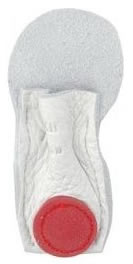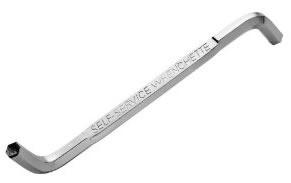The garbage disposal, as shown in Figure 1, is one of those appliances in the home that we all generally take for granted. It is an appliance that we do not see and yet most of us use it every day and many of us use it multiple times a day.

Figure 1 - Garbage disposal
When the garbage disposal is not properly maintained and used it will eventually bread down and it can start to smell-up the kitchen and clog drain lines all of which can cost more to repair then the original cost of the garbage disposal.
You can prevent odors from emanating from your garbage disposal and clogged drain lines by using some basic proper
use of a garbage disposal techniques and some inexpensive preventative maintenance. Maintain and operate your garbage disposal properly and you will have many years of frustration and expense free operations.
The following is the To Do
list, when it comes to operating your garbage disposal:
- Pouring a small amount of dish detergent with cold water into the garbage disposal while it is running for a couple of minutes after you have used it will keep the inside of the garbage disposal clean and eliminate bacteria which causes the odors.
- Run the garbage disposal at least every three days, even if it is only for a minute. This will prevent rust and corrosion from building up in the unit and ensure that all of the internal parts of the garbage disposal are running smoothly. Running the garbage disposal also helps to prevent material from hardening and clogging the unit.
- Use cold water when grinding food waste. Although this may sound wrong, as the cold water will harden grease and oil, it is the hardened material that the garbage disposal can grind up before it reaches the drain line trap under the sink.
- Using your garbage disposal to grind up waste from citrus fruits not only helps clean the garbage disposal but it aids in keeping bacteria from building up and producing bad odors.
- Allow the garbage disposal to completely finish grinding the food before you turn it off. After the garbage disposal has finished grinding the food allow cold water to continue to run into the garbage disposal for at least 15 seconds in order to clear out all of the food waste that was ground.
The following is the Do Not Do
list, when it comes to operating your garbage disposal:
- Do not overload the garbage disposal with large items. Cut large disposable items into small pieces and then feed them into the garbage disposal slowly rather than filling the garbage disposal and then turning it on.
- Do not protect your garbage disposal from materials such as chicken and fish bones, pits from fruit and egg shells. These types of waste material actually scour the inside walls of the garbage disposal and aid in the cleaning process.
- Although we call the appliance a garbage disposal it is really a food disposal. Do not use the garbage disposal in place of a garbage bin! Only food items should be placed in the garbage disposal to be ground up. Non-food items will damage the blades and could burn out the motor.
- Never put the following items into your garbage disposal:
- Do not pour grease, oil or fat directly into the garbage disposal. Grease will build-up on the inside of the drain pipe and garbage disposal walls until it eventually clogs the internal mechanisms of the garbage disposal and drain lines preventing the garbage disposal from working.
- Avoid grinding any fibrous food waste such as corn husks, celery stalks, onion skins and artichokes. The fibers in these food wastes will wrap themselves around the garbage disposal blades and eventually stop the motor from spinning. Fibrous food waste will also clog drains.
- Feed potato peels into the garbage disposal slowly and it is best if they are mixed with other items to be ground. Potato peel has a lot of starch which can turn into a paste and clog the blades as they are rotating.
- Pasta, rice and similar food products expand when they come in contact with any liquid, but especially water. They can easily clog your drain lines and the garbage disposal. Dispose of pasta and rice in your garbage can.
- Do not grind bones from larger animals such as beef, pork and/or lamb. The blades in the garbage disposal are not designed to grind this type of food waste.
- Coffee grounds will not harm your garbage disposal. However they will clog drain lines. It is best to put limited amounts of coffee grounds through the disposal to protect yourself from build-up.
- Do not put drain cleaners through your garbage disposal. Drain cleaners are an acid and can damage the internal workings of the garbage disposal. If you need to use a cleaner of some sort, consider using Borax. Borax is a natural cleaner and sanitizer.
- Every 15 to 20 days you should add three or four ice cubes to your garbage disposal. The ice will actually sharpen the grinding blades and help to break down any grease that may have attached itself to the inside of the garbage disposal. The ice chips act as a scouring agent and as they melt the debris just goes down the drain.
Plastic
Glass
Metal
Paper
Cigarette butts
Combustible materials
How to eliminate odors coming from your garbage disposal:
- Deposit a lemon, orange or other citrus fruit into the garbage disposal. Citrus juice is a natural cleaner and will eliminate most bacteria from the inside walls of the garbage disposal. The oils within the citrus fruit will provide a long lasting odor eliminator.
- Frozen cubes of white vinegar is also an excellent method of keeping your garbage disposal clean and bacteria free and the white vinegar ice chips will scour the inside walls of the garbage disposal in the same manner as the ice cubes.
- If you use baking soda as an odor eliminator in your refrigerator and freezer take the used baking soda and pour it into the mouth of the garbage disposal. Wait two hours and then flush the garbage disposal with cold water.
- If citrus juice, vinegar and baking soda do not eliminate the odors you can try pouring 4 tablespoons of Borax into the garbage disposal and after allowing it to sit for an hour flush it down the drain with hot water.
How to remove an object stuck in the garbage disposal.
Warning: Never place your hand and/or fingers inside the garbage disposal while the circuit breaker for the garbage disposal is in the ON
position. Turn the circuit breaker off or remove the fuse. The blades inside a garbage disposal are razor sharp, even with the power turned off, moving your hand or fingers around inside the garbage disposal can lead to serious cuts.

Figure 2 - Finger gripper
Using a flashlight try to determine the position of the foreign object that is caught in the garbage disposal. Try to dislodge and remove the object using one of the following implements:
- Needle-nose pliers
- Finger gripper, as shown in Figure 2.
- Coat hanger
- Chopsticks
- Crochet needles
- Knitting needles.

Figure 3 - Garbage disposal tool
Troubleshooting your garbage disposal
- If the garbage disposal will not turn on check the following:
- If the garbage disposal plugs into an outlet make sure the plug is seated properly in the receptacle (outlet).
- Push the reset button, usually a black or red button on the side of the garbage disposal case.
- Some garbage disposal units require that they be hand-cranked once they are jammed. This is usually accomplished with a garbage disposal tool, as shown in Figure 3. It should be noted that each manufacture has their own shape and type of tool. The garbage disposal tool is inserted in a hole in the bottom of the garbage disposal and will usually clear most jams.
